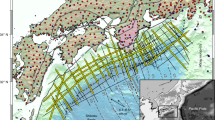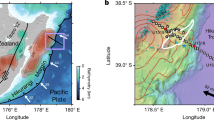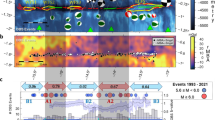Abstract
Subduction zones can exhibit variable seismic behaviour, ranging from great earthquakes to slow slip1. This variability may be linked to fault frictional properties2, and the rheology and structure of the upper plate3. The subduction zone beneath the Nicoya Peninsula, Costa Rica, is characterized by strong variations in fault-slip behaviour and a lateral change in the origin of the subducting plate4,5,6,7. In the northwest, the plate interface is locked8,9, and experiences large, infrequent earthquakes8,9, and the subducting plate is formed at the East Pacific Rise. In contrast, in the southeast, slow-slip events occur frequently10 and the subducting plate is formed at the Cocos–Nazca spreading centre. Here we use seismic receiver-function data to analyse the structure of the subduction zone beneath the Nicoya Peninsula. We find extremely high P–S seismic-velocity ratios within the entire subducting oceanic crust that we interpret as high pore-fluid pressure11,12. Velocity ratios in the overriding continental crust, however, change from lower values in the northwest to higher ones in the southeast, indicating a disparity in fluid accumulation. We infer that this disparity is caused by a higher supply of fluid from the subducting slab in the southeast, owing to the permeability structure of oceanic crust formed at the Cocos–Nazca spreading centre. We suggest that the spatial gradient in fluid content influences upper-plate strength and controls the segmentation of seismogenic behaviour in this subduction zone.
This is a preview of subscription content, access via your institution
Access options
Subscribe to this journal
Receive 12 print issues and online access
$259.00 per year
only $21.58 per issue
Buy this article
- Purchase on Springer Link
- Instant access to full article PDF
Prices may be subject to local taxes which are calculated during checkout




Similar content being viewed by others
References
Schwartz, S. Y. & Rokosky, J. M. Slow slip events and seismic tremor at circum-Pacific subduction zones. Rev. Geophys. 45, RG3004 (2007).
Lay, T. et al. Depth-varying rupture properties of subduction zone megathrust faults. J. Geophys. Res. 117, B04311 (2012).
McCaffrey, R. On the role of the upper plate in great subduction zone earthquakes. J. Geophys. Res. 98, 11953–11966 (1993).
Newman, A. V. et al. Along-strike variability in the updip limit of the seismogenic zone below Nicoya Peninsula, Costa Rica. Geophys. Res. Lett. 29, 1977 (2002).
DeShon, H. R. et al. Seismogenic zone structure beneath the Nicoya Peninsula, Costa Rica, from 3D local earthquake P- and S- wave tomography. Geophys. J. Int. 164, 109–124 (2006).
Harris, R. et al. Thermal regime of the Costa Rican convergent margin: 1. Along-strike variations in heat flow from probe measurements and estimated from bottom-simulating reflectors. Geochem. Geophys. Geosyst. 11, Q12S28 (2010).
Barckhausen, U. et al. Revised tectonic boundaries in the Cocos Plate off Costa Rica: Implications for the segmentation of the convergent margin and for plate tectonic models. J. Geophys. Res. 106, 19207–19220 (2001).
LaFemina, P. et al. Fore-arc motion and Cocos Ridge collision in Central America. Geochem. Geophys. Geosyst. 10, Q05S14 (2009).
Feng, L. et al. Active deformation near the Nicoya Peninsula, Northwestern Costa Rica, between 1996 and 2010: Interseismic megathrust coupling. J. Geophys. Res. 117, B06407 (2012).
Jiang, Y. et al. Slow slip events in Costa Rica detected by continuous GPS observations, 2002–2011. Geochem. Geophys. Geosyst. 13, Q04006 (2012).
Shelly, D. R., Beroza, G. C., Ide, S. & Nakamula, S. Low-frequency earthquakes in Shikoku, Japan, and their relationship to episodic tremor and slip. Nature 442, 188–191 (2006).
Audet, P., Bostock, M. G., Christensen, N. I. & Peacock, S. M. Seismic evidence for overpressured subducting oceanic crust and megathrust fault sealing. Nature 457, 76–78 (2009).
Walter, J. I., Schwartz, S. Y., Protti, J. M. & Gonzalez, V. Persistent tremor within the northern Costa Rica seismogenic zone. Geophys. Res. Lett. 38, L01307 (2011).
Beroza, G. C. & Ide, S. Slow earthquakes and nonvolcanic tremor. Annu. Rev. Earth Planet. Sci. 39, 271–296 (2011).
Hippchen, S. & Hyndman, R. D. Thermal and structural models of the Sumatra subduction zone: Implications for the megathrust seismogenic zone. J. Geophys. Res. 113, B12103 (2008).
Rubinstein, J. L. et al. Seismic wave triggering of nonvolcanic tremor, episodic tremor and slip, and earthquakes on Vancouver Island. J. Geophys. Res. 114, B00A01 (2009).
Liu, Y. & Rice, J. R. Spontaneous and triggered aseismic deformation transients in a subduction fault model. J. Geophys. Res. 112, B09404 (2007).
Segall, P., Rubin, A. M., Bradley, A. M. & Rice, J. R. Dilatant strengthening as a mechanism for slow slip events. J. Geophys. Res. 115, B12305 (2010).
Harris, R. N. et al. Thermal regime of the Costa Rican convergent margin: 2. Thermal models of the shallow Middle America subduction zone offshore Costa Rica. Geochem. Geophys. Geosyst. 11, Q12S29 (2010).
Spinelli, G. A. & Saffer, D. M. Trench-parallel fluid flow in subduction zones resulting from temperature differences. Geochem. Geophys. Geosyst. 8, Q09009 (2007).
Christensen, N. I. Poisson’s ratio and crustal seismology. J. Geophy. Res. 101, 3139–3156 (1996).
Peacock, S. M., Christensen, N. I., Bostock, M. G. & Audet, P. High pore pressures and porosity at 35 km depth in the Cascadia subduction zone. Geology 39, 471–474 (2011).
Dinc, A. N., Rabbel, W., Flueh, E. R. & Taylor, W. Mantle wedge hydration in Nicaragua from local earthquake tomography. Geophys. J. Int. 186, 99–112 (2011).
Ranero, C. R., Morgan, J. P., McIntosh, K. & Reichert, C. Bending-related faulting and mantle serpentinization at the Middle America trench. Nature 425, 367–373 (2003).
Fisher, A. T., Davis, E. E. & Becker, K. Borehole-to-borehole hydrologic response across 2.4 km in the upper oceanic crust: Implications for crustal-scale properties. J. Geophys. Res. 113, B07106 (2008).
Brudzinski, M. R. & Allen, R. M. Segmentation in episodic tremor and slip all along Cascadia. Geology 35, 907–910 (2007).
Outerbridge, K. C. et al. A tremor and slip event on the Cocos-Caribbean Subduction zone as measured by a GPS and seismic network on the Nicoya Peninsula, Costa Rica. J. Geophys. Res. 115, B10408 (2010).
Stankova-Pursley, J., Bilek, S. L., Phillips, W. S. & Newman, A. V. Along-strike variations of earthquake apparent stress at the Nicoya Peninsula, Costa Rica, subduction zone. Geochem. Geophys. Geosyst. 12, Q08002 (2011).
Ghosh, A. A., Newman, A. V., Thomas, A. M. & Farmer, G. T. Interface locking along the subduction megathrust from b value mapping near Nicoya Peninsula, Costa Rica. Geophys. Res. Lett. 35, L01301 (2008).
Hayes, G. P., Wald, D. J. & Johnson, R. L. Slab1.0: A three-dimensional model of global subduction zone geometries. J. Geophys. Res. 117, B01302 (2012).
Acknowledgements
This work is supported by the Natural Science and Engineering Research Council through a Discovery Grant to P.A. and the National Science Foundation through grants OCE-0841061 and EAR-0842338 to S.Y.S.
Author information
Authors and Affiliations
Contributions
P.A. performed data processing and inversion. P.A. and S.Y.S. wrote the paper.
Corresponding author
Ethics declarations
Competing interests
The authors declare no competing financial interests.
Supplementary information
Supplementary Information
Supplementary Information (PDF 6958 kb)
Rights and permissions
About this article
Cite this article
Audet, P., Schwartz, S. Hydrologic control of forearc strength and seismicity in the Costa Rican subduction zone. Nature Geosci 6, 852–855 (2013). https://doi.org/10.1038/ngeo1927
Received:
Accepted:
Published:
Issue Date:
DOI: https://doi.org/10.1038/ngeo1927
This article is cited by
-
Outer trench slope extension to frontal wedge compression in a subducting plate
Earth, Planets and Space (2022)
-
Aseismic slip and recent ruptures of persistent asperities along the Alaska-Aleutian subduction zone
Nature Communications (2022)
-
Crustal Velocity Anomalies in Costa Rica from Ambient Noise Tomography
Pure and Applied Geophysics (2020)
-
Stress-driven fluid flow controls long-term megathrust strength and deep accretionary dynamics
Scientific Reports (2019)
-
Forearc carbon sink reduces long-term volatile recycling into the mantle
Nature (2019)



